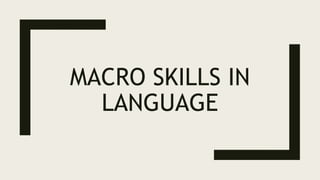
Macro-skills for teaching and learning Language
- 2. MACROSKILLS RECEPTIVE (skills we need to understand the input) ■ LISTENING PRODUCTIVE (skills we use to produce an output) ■ READING ■ SPEAKING ■ WRITING
- 4. FACTORS THAT INFLUENCE LEARNERS’ LISTENING 1. Knowledge of the language system 2. Background knowledge 3. Knowledge of the situation and co-text.
- 5. METHOD OF TEACHING LISTENING SKILLS 1. Bottom-up approach -this method focuses on building students’ understanding of individual sounds, words, or phrases before progressing to larger units of meaning. 2. Top-Down Approach -emphasizes students’ use of their existing knowledge, context, and background information to understand spoken language.
- 6. 3. Interactive Approach -emphasizes active participation and interaction during listening activities. It fosters authentic communication, improves listening comprehension, and enhances speaking skills simultaneously. 4. Task-Based Approach -involves designing listening tasks that stimulate real-life situations and require students to complete specific tasks based on the information they hear. 5. Content-Based Instruction - integrates listening activities with the content of other subject areas.
- 7. 6. Dictation -help students practice listening and writing skills simultaneously while focusing on accurate spelling, punctuation, and sentence structure. 7. Authentic Materials -help develop students’ listening comprehension, cultural understanding, and exposure to natural language. 8. Use of Visual Aids -help students connect the spoken words with visual representations.
- 8. 9. Technology Integration -Utilizing technology resources, such as audio recordings, online listening exercises, and interactive platforms, can engage students and provide opportunities for independent listening practice.
- 9. BEFORE, DURING, AND AFTER LISTENING STRATEGIES BEFORE DURING AFTER • Connec t • Predict • Talk About New Words • Listen for Answers • Take Notes • Re- listen • Respond • Summarize • Extend
- 10. TYPES OF PURPOSEFUL LISTENING 1. Discriminative Listening 2. Comprehensive Listening 3. Therapeutic Listening 4. Critical Listening 5. Appreciative Listening (entertainment)
- 11. TYPES OF LISTENING HABITS 1. Analytical Listening -focuses on what the interaction means to an issue or objective situation and filters what is heard through an interest in results and facts. 2. Conceptual Listening - focuses on the big picture and ideas, often abstract, and filters what is heard through an interest in concepts and possibilities.
- 12. 3. Connective Listening - focuses on what the interaction means for others and filters what is heard through interests in other people, groups, processes, and audiences. 4. Reflective Listening - focuses on what the interaction means for them and filters what is heard through their own interests and purposes.
- 14. FUNCTIONS OF SPEAKING 1. Talk as Interaction (focus is on the speaker/s) 2. Talk as Transaction (focus is on the message) 3. Talk as Performance (talks that transmit info. before an audience.)
- 15. BASIC TYPES OF SPEAKING 1. Imitative Speaking 2. Intensive Speaking 3. Responsive Speaking 4. Interactive Speaking 5. Extensive Speaking
- 16. STAGES IN SPEAKING LESSON 1. Presentation (Pre-activity) Stage 2. Practice Stage - The teacher’s task is to serve as an informant - Students listen and try to understand - The teacher’s task is to be the facilitator - Students do most of the talking 3. Production Stage
- 17. FACTORS THAT INFLUENCE LEARNERS’ SPEAKING 1. Native Language 2. Age 3. Exposure 4. Innate phonetic ability 5. Identity and Language Ego (you are what you speak)
- 18. TEACHING READING
- 19. READING STRATEGIES 1. Scanning - done by looking at the most important details of a text in a quick manner 2. Skimming - focuses on the main idea or general overview of a text.
- 20. READING STRATEGIES 3. Intensive Reading - read and familiarize even the smallest details of a text since a task is going to be accomplished after reading. 4. Extensive Reading -done for fun and pastime and is loose and comfortable since no task or output is expected after reading.
- 21. UNDERSTANDING TEXT ORGANIZATION Understanding the content goes hand in hand with understanding how it is organized. Hence, students need to learn how to relate the following to the text: • Text type (narrative or expository) • Genre • Hierarchy of ideas in exposition • Significant details in narrative and expository texts. • Use of graphic organizers
- 22. Application Reading instruction should also develop the learners’ ability to relate their learning to real-life situations. Reading instructions can end by: • Valuing • Appreciating • Relating lessons to own life • Linking lesson to explain real-life contexts • Responding creatively using multiple intelligences
- 23. Phases in a Reading Lesson • Pre-reading • While Reading • Post-Reading
- 24. Principles for Designing Effective and Interesting Reading Lesson • Reading materials should be interesting for the target learners. • Reading instruction should prioritize students reading the text. • Activities and exercises in a reading lesson should reflect the purposeful, task-based, and interactive nature of real reading (predicting, hypothesizing, and revising ideas about what was read).
- 25. Principles for Designing Effective and Interesting Reading Lesson • Activities and exercises in a reading instruction should allow learners to bring their knowledge and experiences to the text being read. • Reading lessons should focus on teaching and not testing. • There should be a variety of reading activities in each lesson to maintain the interest and motivation of learners. • Reading lessons should be divided into pre-reading, during or while reading, and post-reading phases.
- 26. TEACHING WRITING
- 27. What writers (learners) need to know (Tribble, 1996) 1. Knowledge of the concepts in the subject area. 2. Knowledge of the context in which the text will be read. 3. Knowledge of those aspects of the language system necessary for the completion of the task. 4. Knowledge of the most appropriate way of preparing for a specific writing task.
- 28. Approaches in Teaching Writing 1. Controlled-to-Free Approach 2. Free Writing Approach (quantity rather than quality) 3. Paragraph Pattern Approach 4. Process Approach 5. Product Approach